Israel Trip, Last Part
One last post for you on my journey. First, the Sabbath (Shabbos). I have one photo taken right before I lit candles, grabbed a prayer book, and headed out to the Old City, destination: the Western Wall (Kotel) for evening services welcoming Shabbos.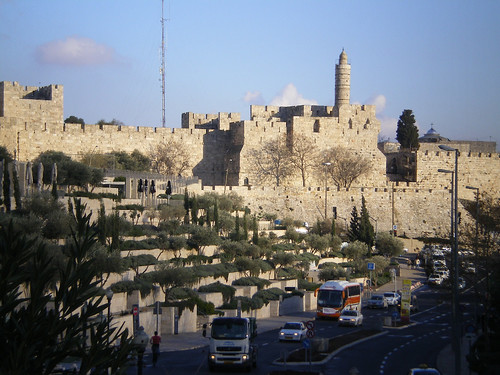
This was the view from the apartment's terrace as traffic came to a relative halt in Jerusalem on the Jewish Sabbath. I write it that way because Israelis, depending upon their religion, may celebrate one of 3 Sabbaths: Friday, Saturday, and Sunday. Sabbath is serious stuff in the Holy Land. I write "relative halt" because non-Jewish tour buses and taxi cabs continued to come to the Old City's walls as I walked: I saw Maronite and Eastern Orthodox tourists, who walked to the Jaffa Gate with me.
As I approached the Jewish Quarter the mood changed. In the Armenian Quarter, business was as usual. Men played backgammon outside their stalls, vendors hawked food and souvenirs, tourists took photos of everything. But in the Jewish Quarter, everyone, everyone was rushing towards the same place. At the Kotel Plaza I saw throngs of people awaiting the time to welcome the Sabbath Queen (that's how we refer to the start of Shabbos). There were uniformed soldiers on leave for Shabbos, waving the national flag across the plaza as they walked to their respective sides of the Kotel. I found a jolly group of American students beginning their prayers next to the divider, their male leader standing on a chair on the men's side so he could direct everyone. That was perhaps the most inspiring welcoming of the Shabbos Queen I ever experienced. There's a prayer where we welcome the Queen and stand up, turning around as if a Queen truly did enter: we beckon to her as we turn to the front again. Singing this hymn at the holiest place was, well, mind-bending and beautiful and awe-inspiring all rolled into one. When the service ended, women and girls joined arms and started singing and dancing to songs I knew very well: David, King of Israel, and most poignantly, Jerusalem of Gold.
The next day I went to the Hurva Synagogue, that very pretty domed one I showed you. As lovely inside as outside. On the way, just outside the Jaffa Gate, a man was handing out leaflets explaining the week's Torah reading. I took one and he immediately asked me if I had a place to eat Shabbos lunch. That's a typical Israeli thing, to find someone to bring home for Shabbos lunch. Me, I tried to bring my friends' daughter, who goes to school in the Old City near the Hurva, home to my brother's for lunch. Alas! she was required to return to school for lunch (they had a guest lecturer that week).
After Shabbos ends, Israel comes back to life- night life. My father wanted his usual early bed time, my brother wanted me to experience Israel, so David and I headed to Ben Yehuda Street, a pedestrian mall about a mile from the apartment. As if we needed more food, we stopped in Cafe Rimon for a light meal. I had onion soup (OK, not great), David had fettucine Alfredo (he said it was good), then I had to try the caramel blintzes with vanilla ice cream. Amazing. Good thing I was doing a lot of walking in Israel.
If I sound a little food obsessed, it's because no one told me Israel had such amazing food. I've been to Italy and France, and Israel can compete with both of those countries!! Check out the shuk I visited on Sunday, the Machne Yehuda: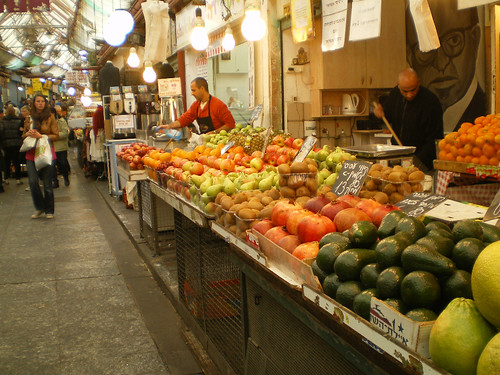
Oy vey! I had to limit myself as I ate my way through the shuk!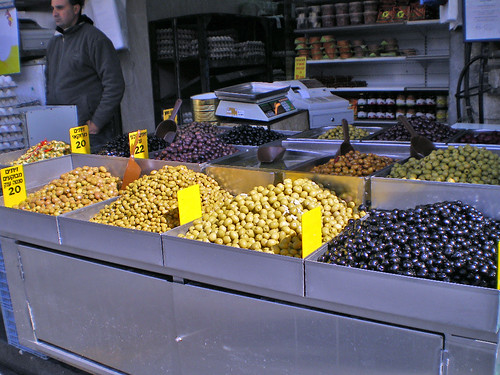
Who knew so many types of olive existed?
After eating through the shuk, I really needed to do some walking in the Old City- and check out some places I was curious about. Like the Burnt House of Kathros. My brother, who lives in Jerusalem part of the time, had no idea what Burnt House was. I had to find out.
So the Burnt House was burnt by the Romans 1 month after the destruction of the second Temple in 70 CE (original name, right?). The Kathros family was of the high priest caste (hey, just like DH!). The cellar survived the conflagration and many artifacts abounded, in part because high priests used a lot of stone vessels in place of pottery.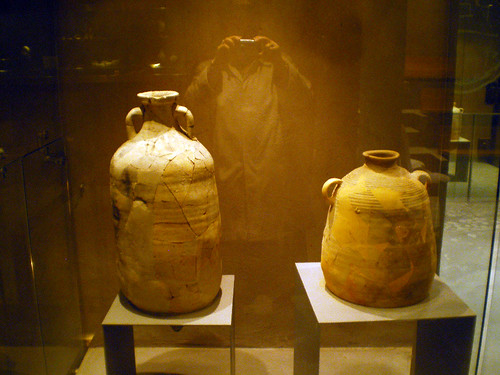
That's me photographing some of the vessels that survived. There was a sword, believed to have been used in the defense of the house, and the skeleton of a young lady (maybe 20 years old) buried in the stones. 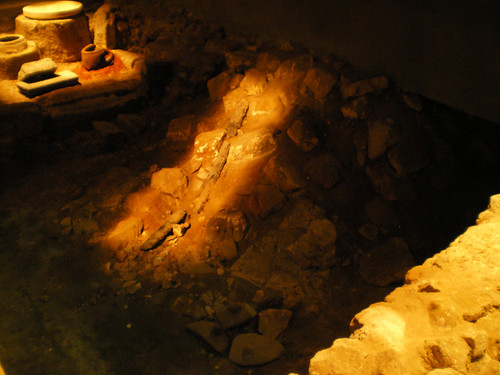
Spooky place.
I spent a while at Burnt House, then wandered until dinnertime.
Monday was my last day, a sad day yet a healing day. First we went to Bet Shemesh, west of Jerusalem, to unveil my mother's monument. The scenery around the cemetery is very striking, a lot like that near Los Angeles. It's a fitting final home for Mom.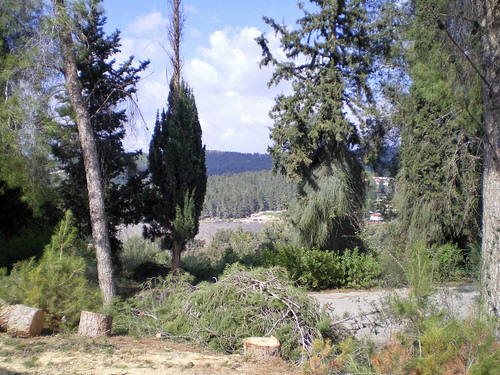
Relatives I'd never met before attended the ceremony from as far away as Kiryat Shemona near the Syrian border (a 3 1/2 hour drive each way) to extend their condolences. DH's cousins who live nearby came also; it felt comforting to see people I knew.
Afterward, I spent the remainder of the day bidding l'hitraot (see you again soon) to the Old City I've come to love so well on such a brief acquaintance.
I explored her nooks and crannies, finding the 8th century CE Karaite Synagogue.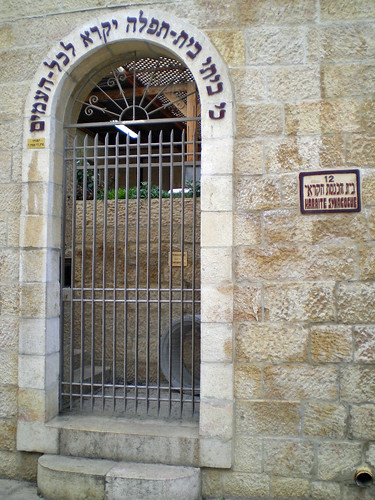
Karaites number only about 40,000 or so; they are Jews who observe Jewish law from the Torah and not from later commentaries on it like the Talmud. This is their sole synagogue (I think) in Israel; they have one in Turkey and 1 in the US and I'm not sure where else they have synagogues. Karaites are believed to have best preserved the writing of the Torah in a form known as the Aleppo codex. To explain this, first let me tell you that a Torah scroll has no vowel marks nor punctuation marks; people reading it memorize the starts and stops, etc. The Aleppo codex (so-called because it was kept in the synagogue in Aleppo, Syria) preserved the Torah in chapter and verse format with vowels and commentaries in margins. I saw the Aleppo codex at the Israel Museum, so the synagogue to me was a link to my historic past.
One of the things Jews do to honor their deceased loved ones, especially parents, is to donate to charity (tzedekah) and to write a Torah scroll in the deceased one's honor. Writing a Torah scroll is an expensive proposition ($10,000 - 20,000), so contributing to the writing of one counts just as much. Part of my plan in the Old City was to give tzedekah and find someone writing a Torah to whom I could give money. In fact, I felt driven to complete these 2 tasks before I left Israel. The person writing the Torah found me here: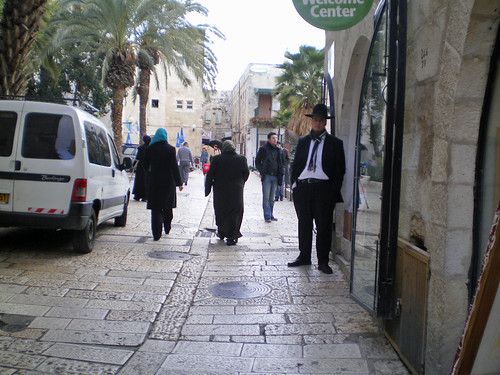
This is outside the Chabad of the Cardo, and they truly were soliciting funds for writing a Torah. When they heard my story, they said G-d sent me. They asked me to write down the names of my entire family, so they could pray for blessings upon us. There's another reason to show you this photo: it's a typical Jerusalem scene. You can see the 2 Arab ladies walking by the entrance to Chabad, the Lubavitcher Chasidic man standing outside the entrance, and different folk walking around the plaza. No one stares at anyone, points fingers, or makes anyone feel awkward.
I had shwarma in the Old City for dinner, then needed something to cleanse my palate (the shwarma was great; the spices linger a bit). I found a candy shop (mints, gum, something sweet) with a bonus: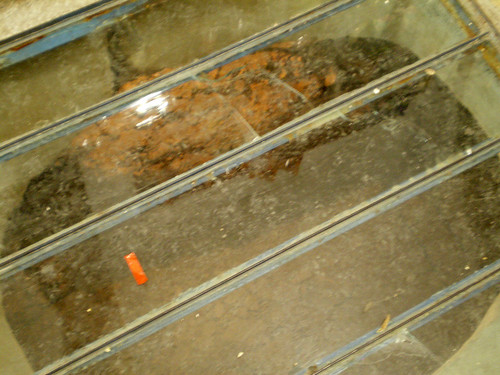
A view down to Roman-era excavations below. Not your everyday sweetshop.
As for the tzdekah, I knew there was a fellow in a wheelchair stationed by Jaffa Gate asking for alms. The previous time I passed him I had no cash. Today I made sure I had cash to give him (in fact, I wound up giving away all my Israeli money instead of changing any back into US currency). Giving away felt as if I had gained something.
I began this post with views of near-sunset, now I'll end it with views of dusk before I headed to Ben Gurion Airport. First, the Montefiore windmill (1857) and Mt. Scopus beyond as seen from outside Jaffa Gate:
Last, evening falling over the Old City.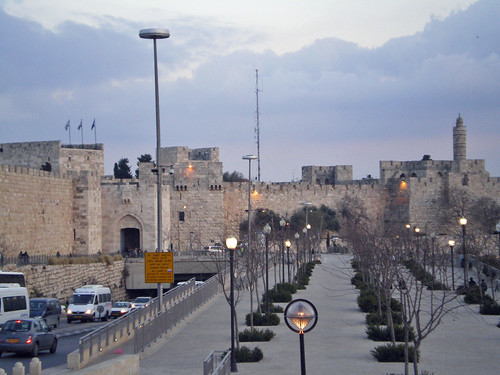
I'll be back soon, I promise, with DH along. We have new places to explore.



2 comments:
Very interesting! Your pictures are great, but I especially love the one of the candy shop with the view down to the excavations. I would love to visit Israel some day.
What incredible (and touching) photographs. Thanks so much for the tour--I really enjoyed it!
And no, I am not running for office :)
Post a Comment